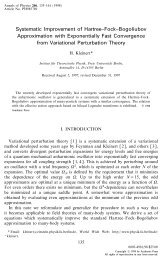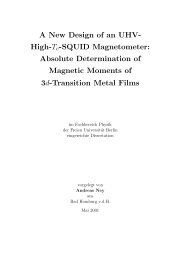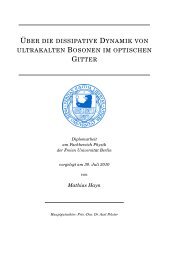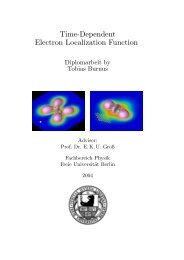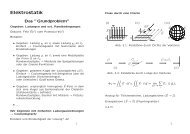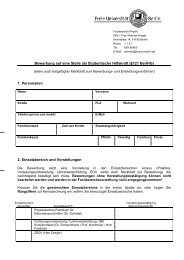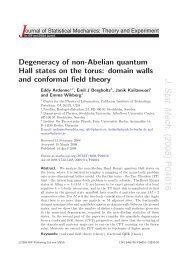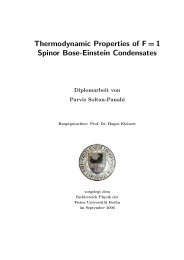Diploma thesis
Diploma thesis
Diploma thesis
Create successful ePaper yourself
Turn your PDF publications into a flip-book with our unique Google optimized e-Paper software.
4 Complex harmonic potential<br />
more. Taking the limit ω → ∞ in (4.37) we have to use the limit of the confluent hypergeometric<br />
functions (4.27) and neglect the first term since the exponential function in the second grows<br />
much stronger than every polynomial in ω. Furthermore we calculate from (4.20) that θ → 1<br />
and multiply the whole expression with the denominator of R s so that all remaining terms have<br />
the denominator Γ(a 1 )Γ(a 2 ). This may be also reasonable since in the considered limit we have<br />
ψ s 2 = ψ s on the whole axis so that it should be lim χ→∞ ψ s 2 (χ) = 0. Otherwise the calculation of<br />
R s in (4.34) could include some division by zero. Since the prefactor of the right-hand side, which<br />
is then the numerator of R s , vanishes in the highest order and all terms of the order 2(a 1 + a 2 ) − 1<br />
in ω cancel each other, there remains only one term of order 2(a 1 + a 2 ) − 3 which has to be equal<br />
to zero. Thus the quantization condition for ω → ∞ reads<br />
lim<br />
ω→∞<br />
ω 2(a 1+a 2 )<br />
Γ(a 1 )Γ(a 2 )<br />
= 0. (4.65)<br />
We want to extract a condition for a 2 from that, which is fulfilled (4.65) for all a 1 , since it is not<br />
realized any more in this system for ω → ∞. Eq. (4.65) is always ensured if a 2 is equal to some<br />
negative integer number a 2 = −n. This yields nothing else than the "real limit" for area 2 since<br />
it is the same result for a 2 like for a 1 in the limit c → 0 or ω → 0 when area 2 disappeared.<br />
Nevertheless it is followed by a different energy which is still complex and contains an imaginary<br />
part which is linear in the depth c of the well:<br />
lim a 2 = 1 ω→∞ 4 (1 − ε ∞ − ic) = −n ⇔ ε s ∞ = 4n + 1 − ic (4.66)<br />
For the wave function this provides<br />
⇔<br />
ψ s 2,∞ (χ) = ψ s ∞ (χ) = N s e − 1 2 χ2 1F 1<br />
(<br />
−n; 1 2 ; ω2 )<br />
(<br />
E∞ s = Ω 2n + 1 )<br />
− iC. (4.67)<br />
2<br />
= (−1) n N s n!<br />
(2n)! e− 1 2 χ2 H 2n (χ) . (4.68)<br />
Evaluating the normalization constant (4.45) in the limit ω → ∞ yields<br />
|N s | = 1<br />
|R s |<br />
⎡<br />
⎢<br />
n∑<br />
⎣<br />
µ,ν=0<br />
(−n) ν (−n) µ<br />
ν!µ! ( ) (<br />
1 1<br />
2 2)<br />
ν<br />
µ<br />
(<br />
Γ µ + ν + 1 ) ⎤ −1/2<br />
⎥ ⎦<br />
2<br />
(4.41)<br />
= 1 [ ∫ ∞<br />
∣ (<br />
2 e − 1 ∣∣∣<br />
|R s 2 χ2 1F 1 −n; 1 )∣ ]<br />
∣∣∣ 2 −1/2<br />
| 0<br />
2 ; χ2 dχ<br />
(4.48)<br />
= (2n)!<br />
n! |R s |<br />
(4.56)<br />
= (2n)!<br />
n! |R s |<br />
[∫ ∞<br />
−∞<br />
√<br />
] −1/2<br />
e − 1 2 χ2 |H 2n (χ)| 2 dχ<br />
1<br />
√ π2<br />
2n<br />
(2n)! , (4.69)<br />
46




